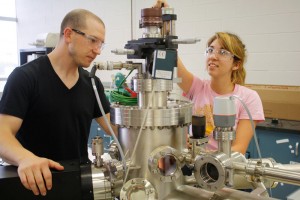A group of researchers including four professors from Drexel’s College of Engineering won a $2.2 million grant from the Office of Naval Research to investigate new electronic devices based on the coupling of electronic and structural phase transitions in oxide materials, according to a University press release issued June 27.
The Drexel professors on the team are Steven May, James Rondinelli, Jonathan Spanier and Mitra Taheri from the Department of Materials Science and Engineering. Professor Andrew Rappe of the University of Pennsylvania’s chemistry department is also involved with the project.

Drexel will receive $1.75 million of the funding for the four-year project, which began this summer.
“We had to apply for the grant and compete against teams from universities all across the country,” May said. “The Office of Naval Research issued what they call a Basic Research Challenge, in which they invited proposals for researchers to develop novel electronic devices based on new materials.”
He estimated the acceptance rate for proposals to be between 10 and 20 percent, and added that most of the proposals are sent from the best universities in the country.
“We really want to develop an electronic device that can improve people’s lives; that is what engineering is all about, making products to improve society. But we have a lot of basic research to do before moving to the technology development end,” May said.
He added that the team’s goal is to develop a new transistor design, like a new electronic on/off switch that can function better than silicon transistors.
Conventional silicon transistors are used by many modern electronic devices like smartphones and laptops, but current transistor technology is limited because engineers’ ability to shrink the size of the component appears to be reaching a threshold.
“Silicon-based transistors are reaching their scaling limitations. This has very real consequences on the performance — not only the speed, but also the power consumption of our portable gadgets,” Rondinelli said in the press release.
The project, which supports MSE graduate students and postdoctoral researchers as well as undergraduate students, will try to develop the use of complex metal oxides, which are earth-abundant compounds mainly composed of oxygen and transition metal elements, like iron or manganese, that can be magnetic, generate electric voltages from small mechanical strains, and allow currents to flow indefinitely without resistance.
According to Rondinelli, “[Complex metal oxides] are pervasive in nature — [they] form a large fraction of the earth’s crust — yet they have curiously escaped, to a large extent, integration in modern devices despite exhibiting a wide range of technologically useful properties.”
Complex metal oxides consist of two or more earth-abundant metals, such as calcium and iron, which combine with oxygen to form a stable compound.
“What makes research into complex oxides so exciting is that materials scientists have developed very powerful and precise tools for synthesizing, characterizing and computationally designing these materials,” May said.
The research conducted by the team will be divided into different departments, with each professor specializing in an important individual aspect.
“In my lab we use a technique known as molecular beam epitaxy to build thin films of oxides one layer of atoms at a time. The technique has been compared to spray painting atoms, and one builds a material with a single layer of paint, or in this case atom, at a time. This allows us to layer the atoms as desired and also to combine multiple materials into a single structure,” May said.
According to May, Rondinelli and Rappe will advise the group in deciding what materials should be synthesized and how they should layer the different compounds.
“Spanier and Taheri will use advanced characterization techniques to investigate the materials. Professor Taheri’s group specializes in transmission electron microscopy, a technique with a magnification so large that it can resolve atoms, to visualize the structure of the materials. Professor Spanier’s group employs advanced spectroscopy techniques to probe the electronic properties and atomic structure of materials,” May said.
The group plans on reporting its research though published papers in scientific journals and presentations at conferences.
“The project will merge the diverse expertise of these researchers toward the common goal of developing the next generation of electronic materials. We anticipate that the interplay of computational materials design with growth and characterization will lead to fundamentally new design principles for devices — some of which have yet to be conceived,” May said.

